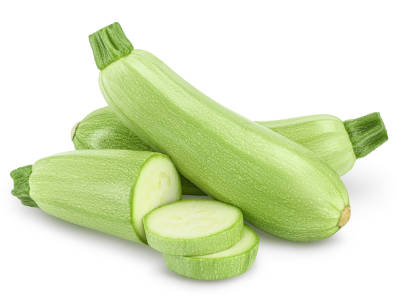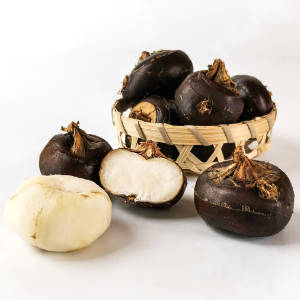Vegetables Category

Vegetables is a catch-all category that includes many of the edible parts of a plant, like stems, roots, flowers, tubers, and leaves. Some biological fruits that aren't very sweet, like tomatoes, squash, peppers, eggplants, and beans, are considered by cooks to be vegetables.
sugar snap
This cross between an English pea and a snow pea is sweet and crisp, and is eaten whole, pod and all. Sugar snaps can be served raw, briefly stir-fried, pickled, or steamed as a side dish.
Learn moresummer squash
Unlike winter squash, summer squash can be eaten rind, seeds, and all. The different varieties vary in size, shape, and color, but they can be used interchangeably in recipes. Select summer squash that are small and firm.
Learn moresushi nori
These thin dark sheets are used to make sushi. They're usually a dark purplish-black, but they turn green and acquire a pleasant, nutty flavor when toasted. You can make your own toasted nori sheets by passing nori sheets over a flame a few times. Yaki means cooked in Japanese, so pretoasted nori sheets are labeled yaki-nori or yaki sushi nori. Look for toasted and untoasted sushi nori in the Asian foods section of large supermarkets. The name nori is also used for laver, the plant that sushi nori is made from. Unlike sushi nori, laver should be rehydrated before use. If you can't find sushi nori, one option is to make sushi without a wrapper. It helps to use plastic wrap to shape the roll.
Learn moresweet dumpling squash
Sweet dumpling squash are fairly small, so you can cut them in half, bake them, and serve each half as an individual portion. The flesh is sweeter and drier than that of other winter squash, and the peel is soft enough to be eaten.
Learn moresweet onion
These onions are mild and crisp, so they're the onions of choice for slicing raw on burgers and sandwiches. They can be lightly cooked, too, though they're not as pungent and flavorful as storage onions. There are several different varieties, often named after the region in which they're grown. The most popular include Vidalia, Walla Walla, Sweet Imperial, Texas Spring Sweet, Texas 1015Y, Carzalia Sweet, Oso Sweet, Arizona, Granex, and Maui. They're usually available from March through August, though some producers extend the season by storing them in a low-oxygen environment. Sweet onions are usually larger than storage onions. They also have a higher water content, so they don't keep as well.
Learn moresweet potato
In American supermarkets, sweet potatoes are displayed next to something called "yams," which are moister than sweet potatoes and have darker skins. But according to the rest of the world (and botanists), we have it all wrong. To them, our "yams" are just a variety of sweet potatoes. They use the word yam to describe a completely different vegetable, something we call a tropical yam. Sweet potatoes are quite versatile, but they're most often baked, candied, or made into pies. It's best not to boil them, as they'll lose much of their flavor.
Learn moreSwiss chard
Swiss chard is used much like spinach, except that it has an appealing beet-like flavor and a heavier texture, which requires longer cooking. Many cooks simply sauté it in olive oil and serve it as a side dish. Red chard = rhubarb chard = ruby chard, with green leaves and red stalks, is slightly more tender and flavorful than white chard = green chard, with white stalks and green leaves, but the two are interchangeable in most recipes.
Learn moretango
This mild green lettuce has ruffled edges, which makes it an interesting salad lettuce
Learn moretaro
If you've sampled poi at a Hawaiian luau, then you're already familiar with taro. Many people don't think much of poi, but taro can be served far more advantageously. It has an interesting, nutty flavor, and it's quite good in stews or soups, or deep-fat fried or roasted. In its raw state, it can be toxic and harsh on the skin, so wear gloves or oil your hands when handling it, and always cook it before serving it.
Learn moretepin dried
These look a bit like large dried cranberries. They're also sold fresh. They are very hot.
Learn moreThai eggplant
These golf-ball sized eggplants are more bitter than American eggplants. They come in different colors, but they're usually green with yellow or white striations. They're often used in hot chile or curry dishes. Remove the bitter seeds before using.
Learn moretomatillo
Tomatillos look like small green tomatoes encased in a papery husk, though they're not true tomatoes.They're pleasantly tart, and principally used to make Mexican salsas, particularly salsa verde. They're good raw, but many cooks cook them briefly in order to enhance their flavor. Frozen tomatillos are good substitutes for fresh. Store fresh ones in the refrigerator for up to a month, or cook them and freeze them.
Learn moretrefoil
Named for the three leaves that sprout from each stem, trefoil has a crunchy texture and aromatic flavor. It's great in salads or as a garnish in soups.
Learn moretropical yam
These firm, white-fleshed yams are widely used in tropical countries. They're somewhat bland and dry, so they're often served with spicy sauces.
Learn moretruffles
Truffles are one of the most expensive of the fungi (technically, they're not mushrooms), but they're packed with flavor. You can grate raw truffles into salads, or chop and sauté them and use them to flavor sauces. Their flavor is complex, so truffles work best in delicately flavored dishes like cream sauces. Truffles are highly perishable, so you should plan to use them within a few days after buying them. To preserve them, add slices of them to bourbon, then use the bourbon and truffle pieces to flavor sauces. Fresh truffles are often sold in containers filled with rice. Don't throw out the rice--it was put there to absorb some of the truffle's exquisite flavor.
Learn moreturban squash
This squash has a gorgeous rind, but ho-hum flavor. It makes a good centerpiece, or you can hollow it out and use it as a spectacular soup tureen.
Learn moreTurkish green pepper
These are long, green, and hot chili peppers. Turks like to grill them and serve them with meat. Don't confuse this fresh pepper with the spice called Turkish pepper.
Learn moreturmeric
Turmeric has a pungent flavor, but it's more widely known for it's brilliant yellow color. You can find fresh roots in Southeast Asian and Indian markets, but dried ground turmeric is far more commonly used. Be careful when handling fresh turmeric--it can stain your hands and clothes.
Learn moreturnip
Turnips can be roasted, boiled, steamed, or stir-fried. Select small turnips that feel heavy for their size.
Learn moreturnip greens
A staple of Southern cuisine, turnips greens are traditionally served with salt pork or ham hocks. The leaves are pungent and slightly bitter, especially older ones, but they become milder when cooked. Don't prepare them with aluminum cookware, as it will affect their flavor and appearance.
Learn moreurfa biber
This is a dried ground chili pepper used in Turkey on meat dishes. It is medium spicy and has a smoky flavor.
Learn morevine tomato
For best flavor, tomatoes should stay on the vine until they're fully ripened. This is a tall order for growers, who prefer to pick tomatoes while they're still green and sturdy, and then gas them with ethylene until they turn red. Vine tomatoes, on the other hand, are picked after they begin to "break" or turn red, which allows them to develop fuller flavor. Expect to pay more for the special handling required to bring these to market.
Learn moreWakame
This has a sweet flavor, and it's rich in calcium. It's often rehydrated and then added to miso soup or sautéed as a side dish. Dry wakame can also be toasted and crumbled over salads and other dishes. It's very high in calcium.
Learn morewater chestnut
Water chestnuts are delightfully sweet and crisp--if you buy them fresh. Though canned water chestnuts are more easily available, they're not nearly as good. Look for fresh water chestnuts in Asian markets. You need to peel off their brown jackets and simmer them for five minutes before stir-frying. If you must use canned water chestnuts, blanch them first in boiling water for thirty seconds.
Learn morewater spinach
This cooking green is very common in the Philippines. Some varieties have purple stems.
Learn more





































































































































































































































































































































































